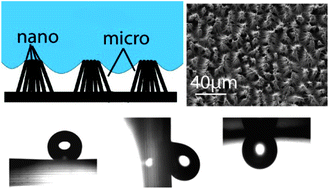Clustered copper nanorod arrays: a new class of adhesive hydrophobic materials
Abstract
Clustered copper nanorod arrays constitute single-component, two-level hierarchical structures that mimic rose petals by showing high contact angles as well as considerable contact angle hysteresis (CAH). The cluster morphology of the nanorod arrays – electrochemically grown within porous alumina templates – is determined by the template geometry and the drying conditions. The CAH (a measure of the adhesion) is a function of the nanorod length and the cluster size to inter-cluster separation ratio. The measured pinning force was 176 μN, among the highest reported. The first level of the hierarchical nano-microstructure consists of the nanorod clusters and the air trapped between them – leading to a Cassie–Baxter type hydrophobicity. The second level comprises the tips of the clustered copper nanorods which pin the water droplets due to the inherently hydrophilic nature of metals. This conjecture is supported by fluorescence imaging and surface polymerization experiments. Thus, a clustered metal nanorod array provides a simple model system for studying the coexistence and complex interplay of hydrophobicity and adhesion, while also providing some degree of control over these mutually contradictory properties.


 Please wait while we load your content...
Please wait while we load your content...